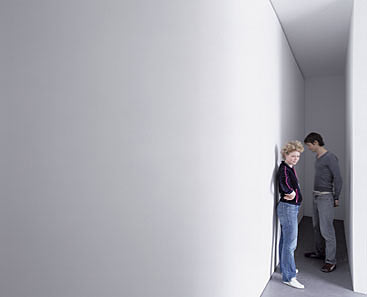
Born in 1974 in Copenhaguen (DK)
Lives and works in Copenhaguen (DK) and Berlin (DE)

2003
Installation
Mur mobile
Dimensions variables
Year of Purchase: 2004
In his amazing novel House of Leaves, writer Mark Danielewski1 proposes a frightening journey into the heart of a strange house whose walls keep shifting. As the story moves along, partitions rise up and the house interior grows or shrinks in an abnormal way, the text is reduced, distended, carried over … the space of the page becomes the material counterpart of the narrative. An experimentation in notes, games with typography, page layout, that refers the vertigo of the story back to the ‘book as object’ that has itself become a sort of in(de)finite labyrinth.
House of Leaves upsets the blank page in the same way that Changing Space deconstructs the white cube. As you enter the exhibition space housing Jeppe Hein’s installation, the first thing you see is the white empty space. And as you expectantly scan this bare place, trying to contradict the emptiness with some clue to a tiny presence, an unusual sensation gradually breaks the surface. A movement becomes more and more obvious, the almost imperceptible movement of one of the room’s walls, which slowly advances and recedes and constantly redefines the viewer’s terri-tory. Independently of them, the work is animated, seeming thus to make the wish for pure artistic autonomy come true. Although the installation is dependent on the architecture, it subsumes the space within its plastic language. Container and contained cross over to the point of merging with each other.
Jeppe Hein’s work is closely connected to Minimal art and openly refers to it, calling upon its aesthetics and precepts. A sum of references that the artist disrupts, exacerbates and releases back with humour. Thus, Changing Space plays around with the process of the viewer’s involvement with the work and its space. It is a shifted application of this will for a ‘crude presence that imposes silence, the better to act physically and intellectually on the viewer,’2 a radical interpretation of the ‘minimal theatricality’ described by the critic Michael Fried. The work goes beyond the limits of its stage and in a very real sense takes over the audience’s seats in the stalls. Acknowledging the disappearance of the public space in favour of the private, it destabilizes the balanced relationship it has with the viewer and with its own setting, the white cube.
This space, whose function from the outset was to ensure autonomy, has gradually altered the very definition of the work. Releasing the art object from any use value, the white cube has in return endowed it with a powerful exchange value (emphasizing its character as cultural merchandise). In Inside the White Cube, Notes on the Gallery Space, the critic Brian O’Doherty notes how the history of modernism has become indissociable from this white box, saying that we have reached a point where what we first see is not the art but the space. What first springs to mind is the image of an ideal white space which, more than any work, will perhaps remain the archetypal image of 20th-century art. Changing Space, then, asserts itself as a reappropriation. Using the architectural codes of the white cube, Jeppe Hein proposes to subtract the space to the point of doing away with it; he constrains or authorizes ‘penetration’ and, at the cost of the viewer’s presence, restores its authority to the work.
Guillaume Mansart
1 Mark Z. Danielewski, House of Leaves, Pantheon Book Inc., New York, 2000.
2 Ghislain Mollet-Viéville, Art minimal et conceptuel, Skira, Geneva, 1995.